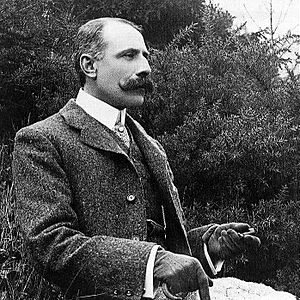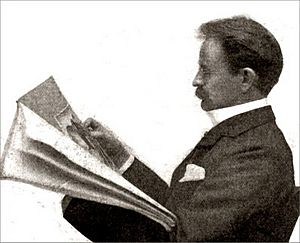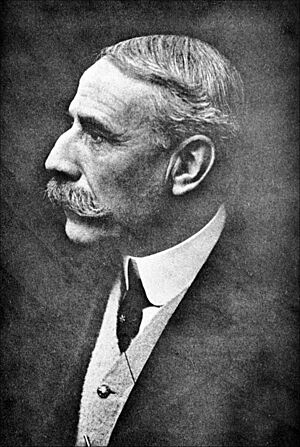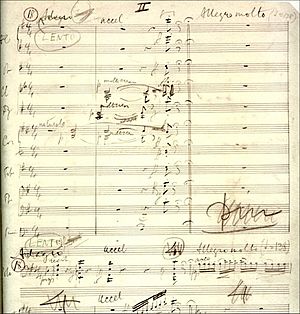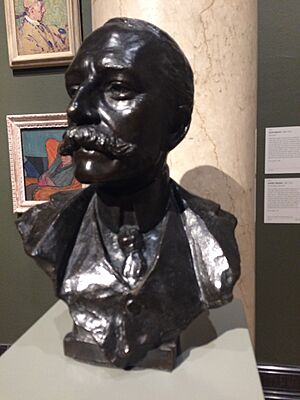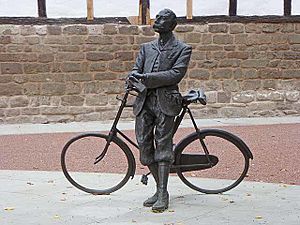Edward Elgar facts for kids
Sir Edward Elgar (born June 2, 1857 – died February 23, 1934) was a famous English composer. Many of his musical pieces are still played in concerts all over the world today. Some of his most well-known works include the Enigma Variations, the Pomp and Circumstance Marches, and concertos for violin and cello. He also wrote two symphonies, choral music like The Dream of Gerontius, and many other pieces. In 1924, he was given the special title of Master of the King's Musick.
Even though Elgar is seen as a very English composer, much of his musical inspiration came from other parts of Europe. He often felt like an outsider. He taught himself music, which was unusual at a time when most composers went to special schools. Also, his family was Roman Catholic in a mostly Protestant country, and he came from a humble background. Despite this, he married Alice Roberts, whose father was a high-ranking army officer. She greatly supported him in his music and life.
Elgar struggled to become famous until he was in his forties. Then, his Enigma Variations (1899) became very popular in Britain and other countries. After that, he wrote The Dream of Gerontius (1900), a choral work that became a classic. In his fifties, he composed a symphony and a violin concerto that were also very successful. His later works, like his second symphony and cello concerto, took longer to become popular. After his death, his music was not played as much, but it became popular again in the 1960s. Today, his music is still played more often in Britain than in other countries.
Elgar was one of the first composers to take music recordings seriously. He conducted many of his own works for recordings, especially after new microphone technology made the sound much better in 1923.
Contents
Biography
Early Life and Musical Start
Edward Elgar was born on June 2, 1857, in a small village called Lower Broadheath, near Worcester, England. His father, William Henry Elgar, was a piano tuner and owned a music shop. His mother, Ann Elgar, loved the arts and encouraged Edward's musical talent. Edward was the fourth of seven children. He was raised Roman Catholic, which his father did not approve of.
Edward started piano and violin lessons when he was eight. His father, who tuned pianos in many grand houses, sometimes took Edward along. This gave Edward a chance to show off his musical skills to important people. He started composing music at a young age. When he was about ten, he wrote music for a play that he and his siblings performed. Years later, he used this music to create his The Wand of Youth suites.
Elgar went to school until he was fifteen. He mostly taught himself music by reading books from the Worcester Cathedral music library. He hoped to study music in Germany, but his family could not afford it. Instead, he worked as a clerk for a lawyer, but he didn't enjoy it. He spent his free time reading and playing music.
He soon left his office job to focus on music. He gave piano and violin lessons and helped in his father's shop. He was very active in Worcester's music groups, playing violin, composing, and conducting. He also conducted a band at the Worcester and County Lunatic Asylum for five years. This job helped him learn a lot about different musical instruments. He also taught violin at the Worcester College for the Blind.
Elgar played violin in festivals in Worcester and Birmingham. He was thrilled to play Dvořák's music with the composer himself conducting. He also played the bassoon in a wind quintet with his brother Frank. He arranged many pieces by famous composers like Mozart and Beethoven for the quintet, which helped him improve his composing skills.
In the early 1880s, Elgar visited Paris and Leipzig, Germany. He heard music by Schumann, Brahms, and Wagner, which inspired him greatly. He also became engaged to a friend, Helen Weaver, but the engagement ended. Throughout his life, many close women friends inspired his music.
Elgar played violin in William Stockley's Orchestra in Birmingham for seven years. He said he "learned all the music I know" there. In 1883, one of his own orchestral pieces, Sérénade mauresque, was performed by a professional orchestra for the first time. Elgar often felt discouraged and short on money during this period, struggling to get his music published.
Marriage and London Life
When Elgar was 29, he started teaching music to Caroline Alice Roberts, known as Alice. She was eight years older than him and had written books and poems. Three years later, they decided to marry. Alice's family was not happy about her marrying a musician who worked in a shop and was Catholic, and she was cut off from her family's money. They married on May 8, 1889.
Alice became Elgar's manager and helped him with his moods. She was also a good music critic. She tried to help him become known in important social circles. Elgar dedicated his violin piece Salut d'Amour to her as an engagement gift. With Alice's encouragement, they moved to London so Elgar could focus on composing. Their only child, Carice Irene, was born in London in 1890. Her name was a mix of her mother's names, Caroline and Alice.
In London, Elgar took every chance to hear new music at the Crystal Palace concerts. He and Alice went often, learning from composers like Berlioz and Richard Wagner. However, Elgar's own music didn't make much of an impact in London at first. He did get one important request from his hometown: to write an orchestral piece for the 1890 Three Choirs Festival. This piece, the Froissart, was his first major work. Because he couldn't find enough work in London, he moved back to Worcestershire in 1891 with his family. They settled in Great Malvern, Alice's former hometown, where he earned a living by teaching and conducting local music groups.
Growing Fame
During the 1890s, Elgar slowly became more known as a composer, especially for the big choral festivals in the English Midlands. Works like The Black Knight (1892) and King Olaf (1896) were somewhat successful. He also wrote the Serenade for Strings (1892). Critics started to notice him, but their reviews were polite rather than excited. He was still struggling financially and felt his music wasn't fully appreciated.
In 1899, everything changed. At 42, Elgar created the Enigma Variations. It was first performed in London by the famous German conductor Hans Richter. Elgar dedicated the piece "To my friends pictured within," as each variation was a musical portrait of one of his friends. The most famous variation is "Nimrod," which represents his friend August Jaeger. The Enigma Variations was praised for its originality and skill, making Elgar the most important British composer of his time.
The Enigma Variations became popular worldwide and is still a concert favorite today. Even though Elgar is seen as a very English composer, this work shows influences from European composers like Richard Strauss.
National and International Success
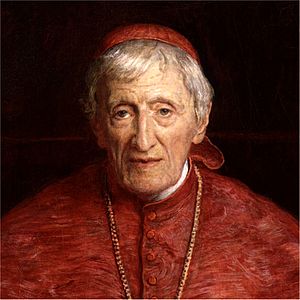
After the success of the Enigma Variations, people eagerly awaited Elgar's next big work. For the Birmingham Triennial Music Festival in 1900, he wrote The Dream of Gerontius, based on a poem by Cardinal John Henry Newman. The first performance was not perfect because the choir wasn't well prepared. However, critics still recognized the brilliance of the music. It was performed in Germany in 1901 and 1902, where it received huge praise. Richard Strauss, a leading composer at the time, even called Elgar "the first English progressive musician." The Dream of Gerontius quickly became popular in Britain and other countries. It is considered one of the greatest British choral works.
Elgar is perhaps most famous for the first of his five Pomp and Circumstance Marches, written between 1901 and 1930. This march is played every year at the Last Night of the Proms and is known worldwide. When Elgar first thought of the main tune for the march, he said, "I've got a tune that will knock 'em – will knock 'em flat." When it was first played in 1901, the audience loved it so much they demanded it be played twice more!
For the coronation of King Edward VII in 1902, Elgar was asked to write a Coronation Ode. The singer Clara Butt suggested that words could be added to the famous tune from the first Pomp and Circumstance march. Elgar asked A. C. Benson to write the words, and this became the song "Land of Hope and Glory". It became incredibly popular and is now like an unofficial national anthem for Britain. In the United States, this tune is often played at high school and university graduations.
In March 1904, a three-day festival of Elgar's music was held in London, an honor never before given to an English composer. The King and Queen attended the concerts. Elgar was knighted (made a Sir) on July 5, 1904. He and his family then moved to a large house in Hereford.
Between 1902 and 1914, Elgar was at the peak of his fame. He visited the United States four times, conducting his music and earning a lot of money. From 1905 to 1908, he was a music professor at the University of Birmingham. He didn't enjoy this job much, as he felt composers should focus on creating music, not teaching. Being famous was difficult for Elgar, who was a private person. He often felt unwell and complained that his life was "one continual giving up of little things which I love."

As he neared his fiftieth birthday, Elgar started working on his First Symphony. When it was first performed in 1908, it was a huge success both in Britain and internationally. It was performed over a hundred times in just over a year.
His Violin Concerto (1910) was written for Fritz Kreisler, a leading violinist. Elgar worked on it with help from W. H. Reed, a violinist who became his close friend. The concerto was a great triumph at its first performance.
However, the Second Symphony (1911) was not as enthusiastically received. Elgar was disappointed, saying the audience "sit there like a lot of stuffed pigs." While it was still successful by normal standards, it didn't create the same excitement as his First Symphony.
Later Works and Final Years
In 1911, Elgar received another high honor, being appointed to the Order of Merit. The next year, the Elgars moved back to London. There, he composed two more large works: The Music Makers (1912) and Falstaff (1913). These were received politely but without great excitement.
When World War I began, Elgar was deeply upset but also felt very patriotic. He joined the local police as a special constable and later the army's volunteer reserve. He wrote patriotic pieces like Carillon and Polonia. "Land of Hope and Glory" became even more popular, though Elgar wished it could have less nationalistic words.
Other works during the war included music for a children's play, The Starlight Express (1915), and The Spirit of England (1915–17), which were choral settings of poems. Towards the end of the war, Elgar's health was poor. He moved to the countryside in Sussex, where he wrote four important works in 1918 and 1919: three chamber pieces (Violin Sonata, Piano Quintet, String Quartet) and the Cello Concerto. The chamber pieces were well received.
However, the Cello Concerto had a very bad first performance in October 1919. The conductor of the rest of the concert took too much rehearsal time, leaving Elgar's piece unprepared. Critics noted the poor performance but praised the concerto itself as "lovely stuff." It took more than a year for the Cello Concerto to be performed again in London.
Elgar's wife, Alice, died in April 1920. He was heartbroken and stopped composing new major works. Without Alice's support, he focused on his hobbies. He was a keen amateur chemist and even patented an invention. He loved football (soccer) and supported Wolverhampton Wanderers F.C., even writing an anthem for them. He also enjoyed horse racing and cycling. In 1923, he traveled to Brazil, journeying up the Amazon.
After Alice's death, Elgar moved back to Worcestershire. He still composed some pieces, like his Empire March for the 1924 British Empire Exhibition. In 1924, he was again appointed Master of the King's Musick.
From 1926 onwards, Elgar made many recordings of his own music. He was one of the first composers to use the new electrical recording technology, which made sound much clearer. He recorded most of his major orchestral works. These recordings are famous for their faster speeds compared to how many conductors play his music today.
In 1931, Elgar was filmed conducting Pomp and Circumstance March No. 1 at the opening of Abbey Road Studios in London. This is the only surviving sound film of him. He also wrote a new piece called the Nursery Suite, using some of his childhood musical ideas.
In his final years, Elgar's music became popular again. The BBC held a festival for his 75th birthday in 1932. He began working on an opera and a Third Symphony, but he became ill and could not finish them. He died on February 23, 1934, at age 76, and was buried next to his wife. Later, other composers used his sketches to complete his Third Symphony and a Sixth Pomp and Circumstance March.
Music
Elgar's Musical Style
Elgar wasn't very interested in old English folk music or early English composers. He admired Purcell and learned from Hubert Parry's writings. His biggest influences were European composers like Handel, Dvořák, and Brahms. You can also hear the influence of Wagner in his music, but his unique way of using instruments (orchestration) was inspired by French composers like Berlioz and Delibes.
Elgar started composing as a child and often used ideas from his old sketchbooks throughout his life. His early works included pieces for violin, piano, and the wind quintet he played in. Some of these early pieces, like Salut d'Amour and The Wand of Youth suites, are still played today. His overture Froissart was a romantic piece showing his growing style. He also wrote the Serenade for Strings and Three Bavarian Dances.
His main early large works were for choir and orchestra, written for festivals. These included The Black Knight and King Olaf. While these pieces showed his skill in orchestration, his first truly great success was the Enigma Variations. This work showed how much his orchestral skills had grown over the years.
His Most Famous Works
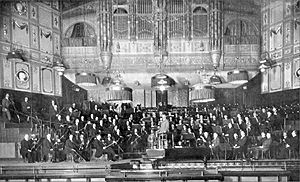
Elgar's most famous pieces were written between 1899 and 1920. Many of them are for orchestra. The Enigma Variations made him famous. This piece, with its musical portraits of friends, showed his amazing skill in using different instruments. His next orchestral works, like Cockaigne and the first two Pomp and Circumstance marches, are shorter but very popular. In the South is a longer orchestral piece inspired by a holiday in Italy. In 1905, he wrote the Introduction and Allegro for Strings, a masterpiece for string instruments.
Over the next four years, Elgar composed three major concert pieces: his First Symphony, Violin Concerto, and Second Symphony. These are long and powerful works, considered very important in English music history. They use classical forms but also have Elgar's unique dramatic style.
Elgar's Violin Concerto and Cello Concerto are considered among his best works. The Violin Concerto, written in 1909, is very lyrical and brilliant. The Cello Concerto, written a decade later after World War I, is simpler and more thoughtful. Between these two concertos, he wrote Falstaff, an orchestral study that some consider one of his greatest works, while others have mixed feelings. Elgar himself thought Falstaff was his best orchestral piece.
His major works for voices and orchestra include The Dream of Gerontius (1900) and the oratorios The Apostles (1903) and The Kingdom (1906). Gerontius is the most loved and performed of these. Elgar's special way of using instruments and his beautiful melodies make these works stand out from earlier British pieces.
Later Works and Legacy
After the Cello Concerto, Elgar didn't complete any more large-scale works. He arranged pieces by other composers like Bach and Handel. He also used his old childhood ideas for the Nursery Suite (1931). For many years, people thought Elgar's creativity stopped after his wife died. However, when his sketches for a Third Symphony were completed by another composer, Anthony Payne, in 1997, it showed that Elgar's later music had a different, more stark sound.
How Elgar is Seen Today
Opinions on Elgar's music have changed over time. Early on, composers like Richard Strauss and Hans Richter praised him as a modern and great composer. However, after World War I, his music was seen as old-fashioned. In the 1920s, his works were not played as often.
By the 1960s, interest in Elgar's music grew again. People started to appreciate the Edwardian era more. Critics like David Cox noted that while Elgar used European musical styles, his unique personality shone through, making his music truly "English." Other composers like Sibelius and Stravinsky also recognized his unique English character in music.
There is still some debate among Elgar fans about which of his works are his absolute masterpieces. The Enigma Variations, The Dream of Gerontius, and the Cello Concerto are generally considered top works. The Violin Concerto is also highly rated by many.
Despite changing opinions, Elgar's major works have become very popular again since the 1950s. Many recordings of his symphonies, concertos, and choral works are now available. His music is frequently performed in concerts around the world, especially in Britain.
Honors and Memorials

Elgar received many honors during his life. He was knighted in 1904, made a member of the Order of Merit in 1911, and became Master of the King's Musick in 1924. He also received honorary degrees from many universities, including Yale in the USA. In 1931, he was made a Baronet.
The house where Elgar was born in Lower Broadheath is now the Elgar Birthplace Museum. It is dedicated to his life and music. His daughter, Carice, helped create the museum and gave it many of his letters and documents.
There are several statues of Elgar in England. One stands in Worcester High Street, facing the cathedral, near where his father's shop used to be. Another is in Malvern, overlooking the town. A third statue in Hereford shows Elgar with his bicycle, honoring his connection to the city.
From 1999 to 2007, Elgar's portrait was featured on the Bank of England twenty pound notes. This change caused some discussion, especially since 2007 was the 150th anniversary of his birth.
Elgar's life and music have also inspired books and plays. The 1962 BBC television film Elgar by Ken Russell helped bring his music back into public attention, showing the more thoughtful side of his character.
See also
 In Spanish: Edward Elgar para niños
In Spanish: Edward Elgar para niños


